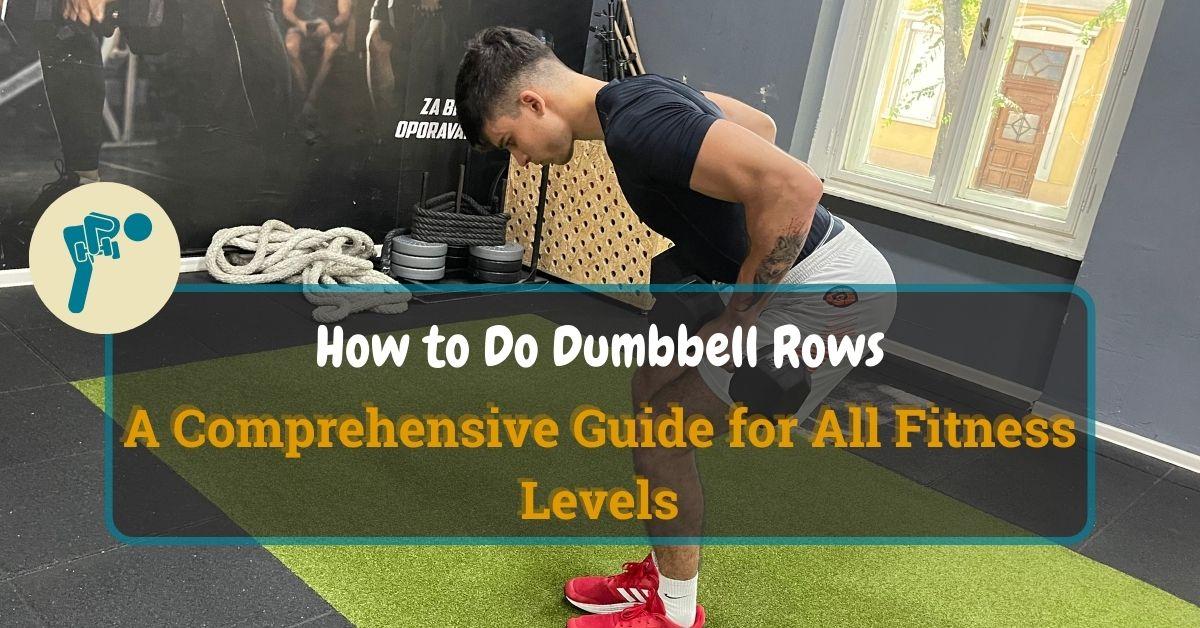Dumbbell rows are a classic exercise that should be in every gym-goer’s arsenal. They’re versatile, effective, and accessible regardless of your fitness level.
Table of Contents
ToggleAs a Faculty of Sport and Physical Education student, it took me over 30 hours to fully research, evaluate, and single out only the most important information regarding how to do dumbbell rows.
In this comprehensive guide, we’ll break down how to perform dumbbell rows, delve into the muscles they target, and share some useful tips for beginners and seasoned fitness enthusiasts alike.
Start Building Your Dream Body Today
Ready to elevate your fitness game without falling into the trap of dull, repetitive routines that just don’t deliver? Imagine sculpting your ideal physique and boosting your health, all while still enjoying life’s pleasures, like those irresistible weekend getaways and your aunt’s legendary cheesecake. With our online fitness and nutrition coaching service, you don’t have to compromise. Dive into a personalized fitness journey that blends perfectly with your lifestyle, not against it. Book your completely free discovery consultation today, and take the first step towards a transformation that doesn’t require giving up the joys of life.

“I was skeptical about online fitness coaching, but Functional Body Savage completely changed my perspective. Vanja and Radomir’s personalized approach and attention to detail have helped me achieve goals I never thought possible. I’m stronger, more confident, and grateful for their guidance.”
Emily Thompson, San Francisco, CA
Learn More About Our Online Coaching ServiceQuick Summary
- This comprehensive guide provides detailed steps on performing dumbbell rows correctly, emphasizing the importance of starting position, maintaining a neutral spine, controlling the pull and lower of the weight, and key tips such as pulling with your elbows, not hands, and maintaining a slow, controlled pace throughout the exercise.
- Common mistakes such as rushing the movement, incorrect back position, and lifting too heavy are discussed along with advice on how to avoid them; additionally, the article covers a range of dumbbell row variations and progressions to suit different fitness levels from beginners to advanced.
- The guide also highlights the need for a well-rounded fitness routine and proper nutrition while outlining the importance of safety guidelines and injury prevention in performing dumbbell rows.
Understanding Dumbbell Rows
Before we get into the technique, let’s understand what a dumbbell row is.
The bent-over dumbbell row exercise is a pulling movement that primarily targets your back muscles and shoulder blades, especially the latissimus dorsi (lats), rhomboids, and trapezius.
Secondary muscles include the biceps, brachialis, brachioradialis, erector spinae, and obliques.
How to Do Dumbbell Rows: Proper Form and Technique
To do dumbbell rows correctly, follow the steps below:
- Starting position: Stand upright with a dumbbell in each hand, palms facing your torso. Keep your feet hip-width apart.
- Bend and brace: Bend your knees slightly and hinge forward from your hips, maintaining a straight, neutral spine. This bent-over position is where you’ll perform the exercise. You can place one hand on a bench or sturdy object to provide additional support.
- The pull: Keep your torso stationary and pull the dumbbells towards your torso, keeping your elbows close to your body. Your elbows should drive the motion, and you should squeeze your back muscles at the top of the lift.
- The lower: Lower the dumbbells back to the starting position in a controlled motion, fully extending your arms and feeling a stretch in your lats.
Key points to remember:
- Keep your back straight throughout the exercise. Avoid rounding or arching it to prevent strain or injury.
- Perform the exercise slowly and with control. This isn’t a momentum-driven move, so focus on using your upper back and upper arm muscles, and avoid not swinging your arms.
- Always pull with your elbows, not your hands. Think of your arms as hooks connecting the dumbbells to your body.
Common Mistakes to Avoid
Below are listed common dumbbell rowing mistakes to avoid.
- Rushing the Movement: Each movement phase should be deliberate and controlled. Avoid the temptation to rush the exercise, particularly during the lowering phase.
- Incorrect Back Position: Maintain a neutral spine throughout the exercise. A rounded or excessively arched back can lead to injury.
- Lifting Too Heavy: Always choose a weight that allows you to maintain proper form. Lifting too heavy can compromise your form and increase the risk of injury.
Dumbbell Row Variations and Progressions
Once you’re comfortable with performing dumbbell rows, you can try some dumbbell row alternatives to add variety and challenge to your routine:
- Single-Arm Dumbbell Row: Similar to the classic dumbbell row, but performed one arm at a time. This allows for greater focus on each side and can help address muscle imbalances.
- Bent-Over Two-Dumbbell Row: You lift both weights simultaneously in this bent-over rows variation. This bent-over row requires more core stability and can save time.
- Renegade Row: This variation starts in a high plank position with a dumbbell in each hand. Perform a row with one arm while maintaining the plank with the other, providing a full-body workout.
Incorporating the Bent Over Dumbbell Row Into Your Workout
Dumbbell rows can be part of an upper-body workout, a back-focused session, or a full-body routine.
They pair well with pushing exercises like bench or shoulder presses, helping balance your muscle groups and improving overall strength and body composition.
Whether you’re a beginner or a seasoned gym-goer, the humble dumbbell or bent-over barbell row is a valuable addition to your fitness routine.
Its ability to target multiple muscle groups and its many variations offers endless opportunities for progression.
Remember, the key to any exercise is proper form and technique. Start light, master the form, and gradually increase the weight as your strength improves.
Modifying Dumbbell Rows for Different Fitness Levels
Adaptability is one of the strongest aspects of the dumbbell row, and it can be tweaked to suit any fitness level:
- Beginners: If you’re new to strength training or dumbbell rows, begin with light weights or even without any weights. The key is to become comfortable with the movement and ensure your form is correct before adding weight. An excellent place to start is the single-arm dumbbell row using a bench for support.
- Intermediate: For those comfortable with the basic dumbbell row, it’s time to increase the weight. Ensure you perform 8-12 reps well before upping the weight. Introduce variations like the bent-over two-dumbbell or renegade row to your routine.
- Advanced: For seasoned gym-goers, try advanced variations like renegade rows or more massive weights. You could also experiment with tempo, such as slowing down the lowering phase for a greater challenge. As always, the proper form precedes the amount of weight lifted. You can also proceed with more advanced rowing variations, such as the single arm lat row on the cable machine for maximal lat hypertrophy.
Supplementing Your Dumbbell Rows
While dumbbell rows are a comprehensive exercise, they shouldn’t be the only tool in your arsenal.
They should be part of a well-rounded fitness routine that targets all major muscle groups.
Complement your dumbbell rows with other compound exercises like squats, deadlifts, and bench presses for a balanced strength-training program.
The Role of Nutrition
Proper nutrition is crucial for any fitness program.
Ensure your diet is rich in lean proteins, complex carbohydrates, healthy fats, and plenty of fruits and vegetables to fuel your workouts and recovery.
Safety and Injury Prevention
Bent-over dumbbell rows are generally safe when done correctly. However, improper form or lifting too heavy can injure the entire upper body.
Remember these safety guidelines:
- Always warm up before starting your workout.
- Don’t rush through the movement.
- Keep your back straight and neutral.
- If you feel any pain, stop immediately.
FAQs
How Do You Do Dumbbell Rows for Beginners?
You do dumbbell rows for beginners by standing with your feet hip-width apart, holding a light dumbbell in one hand, bending your knees slightly, and hinging forward from your hips; then pull the dumbbell up towards your chest, keeping your elbow close to your body, and slowly lower it back down. Use a bench for support by placing your free hand on it for stability.
Are Dumbbell Rows Good for You?
Yes, dumbbell rows are good for you. Dumbbell rows are excellent for your fitness routine as they target multiple muscle groups, including the latissimus dorsi, rhomboids, and trapezius, which can help build strength, improve posture, and enhance overall fitness.
How to Do a Dumbell Row on a Bench?
To do a dumbbell row on a bench, kneel on the bench with one knee and place the same side hand on the bench for support, hold a dumbbell in the other hand with your arm fully extended, and then pull the dumbbell upwards until your elbow is above your back, then slowly lower it back down. Keep your back flat and parallel to the ground throughout the exercise.
Should Dumbbell Rows Be Fast or Slow?
Dumbbell rows should be slow. Dumbbell rows should be performed at a slow and controlled pace to ensure muscle activation and minimize injury risk. The key is focusing on muscle contraction and relaxation during the exercise, not speed.
Where Should I Feel Dumbbell Rows?
You should feel dumbbell rows in your back muscles, especially in the latissimus dorsi, rhomboids, and trapezius, with secondary engagement in your biceps and core, as these muscles are also worked during the exercise. Always use the correct form to target the intended muscles and avoid injury.
Can I Build Strong Back Muscles by Only Doing Row Workouts at Home?
Yes, you can build strong back muscles by only doing row workouts at home.
However, you will need appropriate home gym equipment for those workouts to ensure the most significant strength and muscle hypertrophy effects.
I suggest reading our guide on the best dumbbells for home gym to pick the ones that suit your goals, needs, and personal budget best.
In the comments below, let me know your biggest difficulties regarding proper dumbbell row technique so I can help you.
Start Building Your Dream Body Today
Ready to elevate your fitness game without falling into the trap of dull, repetitive routines that just don’t deliver? Imagine sculpting your ideal physique and boosting your health, all while still enjoying life’s pleasures, like those irresistible weekend getaways and your aunt’s legendary cheesecake. With our online fitness and nutrition coaching service, you don’t have to compromise. Dive into a personalized fitness journey that blends perfectly with your lifestyle, not against it. Book your completely free discovery consultation today, and take the first step towards a transformation that doesn’t require giving up the joys of life.

“I was skeptical about online fitness coaching, but Functional Body Savage completely changed my perspective. Vanja and Radomir’s personalized approach and attention to detail have helped me achieve goals I never thought possible. I’m stronger, more confident, and grateful for their guidance.”
Emily Thompson, San Francisco, CA
Learn More About Our Online Coaching Service




